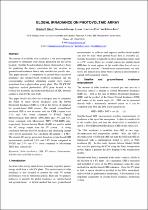JavaScript is disabled for your browser. Some features of this site may not work without it.
- ResearchSpace
- →
- Research Publications/Outputs
- →
- Conference Publications
- →
- View Item
| dc.contributor.author |
Mkasi, Hlaluku W

|
|
| dc.contributor.author |
Basappa Ayanna, Manjunath

|
|
| dc.contributor.author |
Pratt, Lawrence E

|
|
| dc.contributor.author |
Roro, Kittessa T

|
|
| dc.date.accessioned | 2019-03-11T06:39:07Z | |
| dc.date.available | 2019-03-11T06:39:07Z | |
| dc.date.issued | 2018-06 | |
| dc.identifier.citation | Mkasi, H.W., Basappa Ayanna, M., Pratt, L.E. and Roro, K.T. 2018. Global irradiance on photovoltaic array. 5th Southern African Solar Energy Conference, 5-27 June 2018, Blue Waters Hotel, Durban, South Africa, 5pp. | en_US |
| dc.identifier.issn | 21016 | |
| dc.identifier.uri | http://www.sasec.org.za/documents/SASEC2018_programme.pdf | |
| dc.identifier.uri | http://hdl.handle.net/10204/10774 | |
| dc.description | Paper presented at the 5th Southern African Solar Energy Conference, 25-27 June 2018, Blue Waters Hotel, Durban, South Africa | en_US |
| dc.description.abstract | The amount of available solar irradiance is the most important parameter to determine solar energy generation for any given location. Satellite-based irradiance data is often used as a basis for predicting the energy generation for any location, as ground-based irradiance data is only available for specific sites. This paper presents a comparison of ground-based measured irradiance and satellite-based predicted irradiance and the corresponding modelled alternating current (AC) energy generation from a photovoltaic power plant. The 558 kW DC single-axis tracked photovoltaic (PV) plant located at the Council for Scientific and Industrial Research (CSIR) Pretoria campus is used for the case study. This paper briefly describes the techniques used to determine the Plane of Array (POA) irradiance from the Global Horizontal Irradiance (GHI) as well as the theory of operation for ground-based GHI sensors. The annual ground-based measured GHI at two locations with the CSIR campus were 3.1% and 4.9% lower compared to PVGIS Typical Meteorological Year (TMY) (1998-2011) and 1.9% and 3.6% lower compared with Meteonorm TMY (1960-2000) data, respectively. System Advisor Model (SAM) was used to model the AC energy output from the PV system. A strong correlation between the POA irradiance and alternating current (AC) power generation was calculated (R-squared = 0.987). The annual AC energy generation based on ground-based GHI measurements predicted 3.6% and 5.9% lower compared to PVGIS and 2.4% and 4.7% lower compared to Meteonorm TMY data, respectively. | en_US |
| dc.language.iso | en | en_US |
| dc.relation.ispartofseries | Worklist; | |
| dc.subject | Solar irradiance | en_US |
| dc.subject | GHI | en_US |
| dc.subject | PV system | en_US |
| dc.subject | Pyranometer | en_US |
| dc.subject | Satellite data | en_US |
| dc.subject | POA irradiance | en_US |
| dc.title | Global irradiance on photovoltaic array | en_US |
| dc.type | Conference Presentation | en_US |
| dc.identifier.apacitation | Mkasi, H. W., Basappa Ayanna, M., Pratt, L. E., & Roro, K. T. (2018). Global irradiance on photovoltaic array. http://hdl.handle.net/10204/10774 | en_ZA |
| dc.identifier.chicagocitation | Mkasi, Hlaluku W, Manjunath Basappa Ayanna, Lawrence E Pratt, and Kittessa T Roro. "Global irradiance on photovoltaic array." (2018): http://hdl.handle.net/10204/10774 | en_ZA |
| dc.identifier.vancouvercitation | Mkasi HW, Basappa Ayanna M, Pratt LE, Roro KT, Global irradiance on photovoltaic array; 2018. http://hdl.handle.net/10204/10774 . | en_ZA |
| dc.identifier.ris | TY - Conference Presentation AU - Mkasi, Hlaluku W AU - Basappa Ayanna, Manjunath AU - Pratt, Lawrence E AU - Roro, Kittessa T AB - The amount of available solar irradiance is the most important parameter to determine solar energy generation for any given location. Satellite-based irradiance data is often used as a basis for predicting the energy generation for any location, as ground-based irradiance data is only available for specific sites. This paper presents a comparison of ground-based measured irradiance and satellite-based predicted irradiance and the corresponding modelled alternating current (AC) energy generation from a photovoltaic power plant. The 558 kW DC single-axis tracked photovoltaic (PV) plant located at the Council for Scientific and Industrial Research (CSIR) Pretoria campus is used for the case study. This paper briefly describes the techniques used to determine the Plane of Array (POA) irradiance from the Global Horizontal Irradiance (GHI) as well as the theory of operation for ground-based GHI sensors. The annual ground-based measured GHI at two locations with the CSIR campus were 3.1% and 4.9% lower compared to PVGIS Typical Meteorological Year (TMY) (1998-2011) and 1.9% and 3.6% lower compared with Meteonorm TMY (1960-2000) data, respectively. System Advisor Model (SAM) was used to model the AC energy output from the PV system. A strong correlation between the POA irradiance and alternating current (AC) power generation was calculated (R-squared = 0.987). The annual AC energy generation based on ground-based GHI measurements predicted 3.6% and 5.9% lower compared to PVGIS and 2.4% and 4.7% lower compared to Meteonorm TMY data, respectively. DA - 2018-06 DB - ResearchSpace DP - CSIR KW - Solar irradiance KW - GHI KW - PV system KW - Pyranometer KW - Satellite data KW - POA irradiance LK - https://researchspace.csir.co.za PY - 2018 SM - 21016 T1 - Global irradiance on photovoltaic array TI - Global irradiance on photovoltaic array UR - http://hdl.handle.net/10204/10774 ER - | en_ZA |






